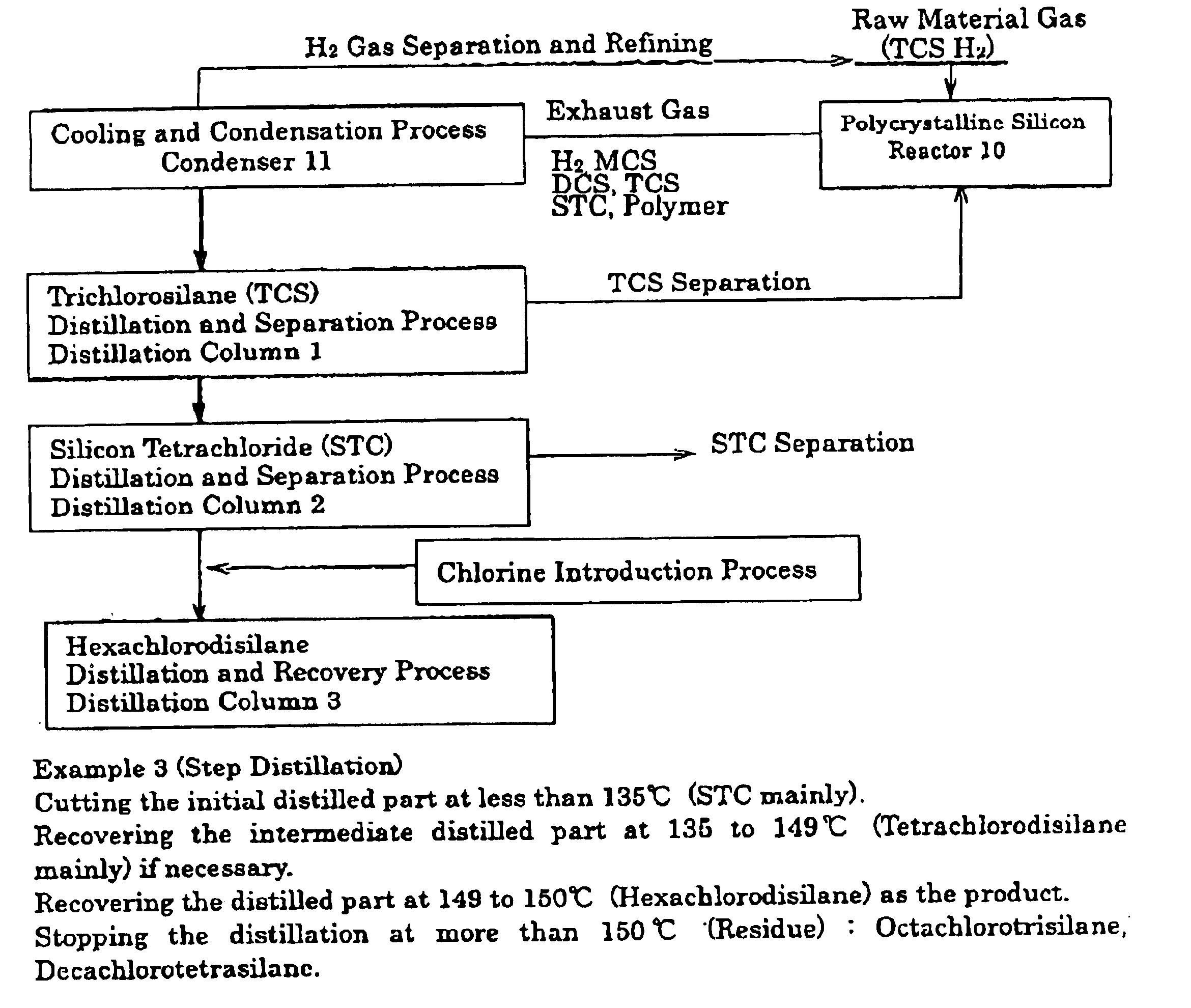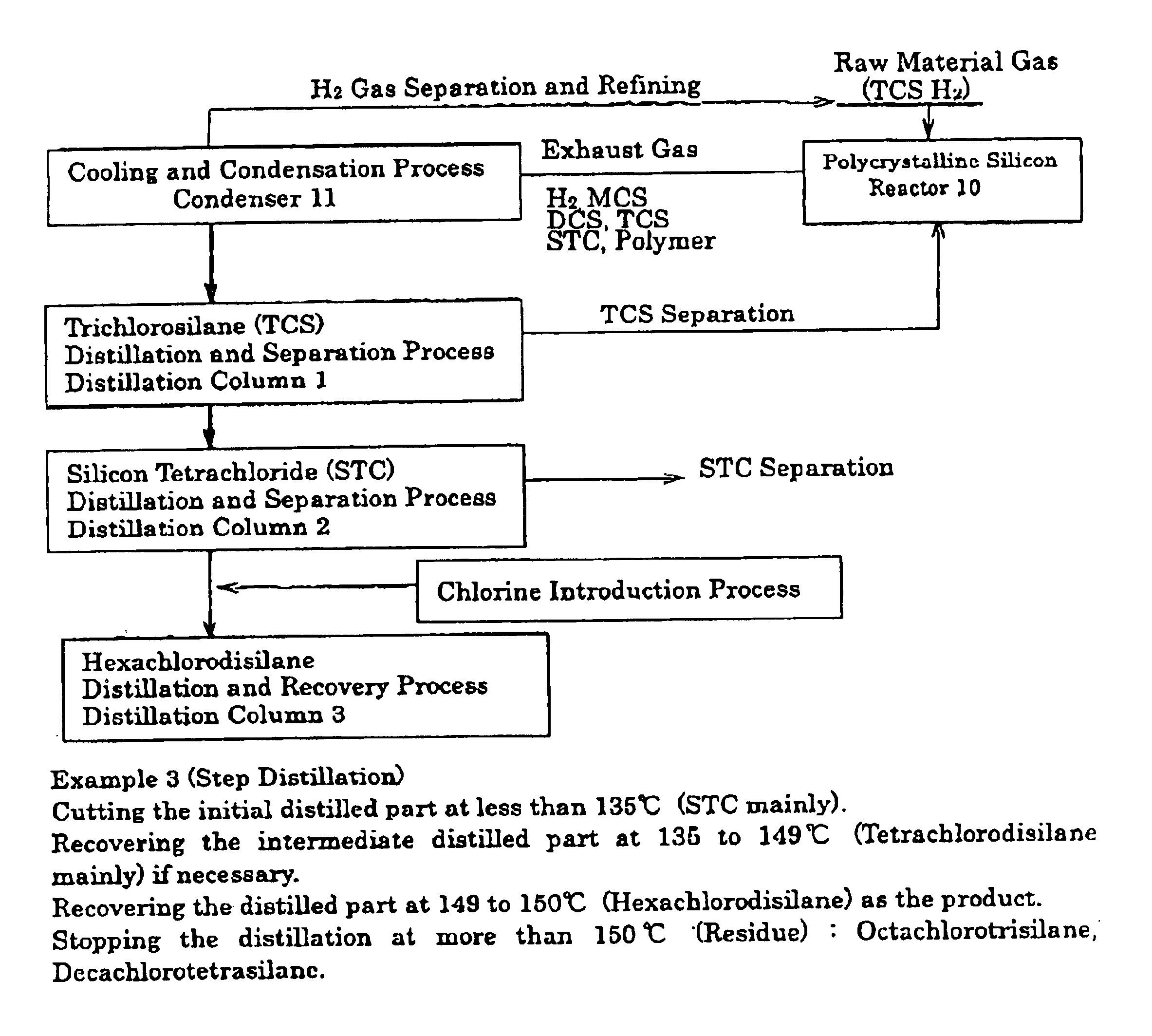Process for producing hexachlorodisilane
a technology of hexachlorodisilane and process, which is applied in the direction of halogenated silane, separation process, silicon compound, etc., can solve the problems of unavoidable contamination of the hexachlorodisilane produced, difficult separation, and metallic impurities in low-grade silicon form contaminates in the product mixture, etc., to achieve efficient recovery, increase the recovery rate, and the effect of high purity
- Summary
- Abstract
- Description
- Claims
- Application Information
AI Technical Summary
Benefits of technology
Problems solved by technology
Method used
Image
Examples
example 1
[0039]In the reaction system, where the polycrystalline silicon was deposited on the surface of the heated body at about 1000° C. in the reactor 10, where the mixed gas of trichlorosilane and hydrogen was sealed, by thermal cracking and hydrogen reduction. In this reaction system, as shown in FIG. 1, the exhaust gas (6910 Nm3 / hr) discharged from the reactor 10 was introduced into condenser 11 to be cooled until −55° C. While the uncondensed hydrogen gas was recovered to be sent to the reactor 10, the condensed water (4.2 m3 / hr) was fed into distillation column 1, and the distillation temperature was set to 52° C. at 0.1 MPaG. Then, the distilled part (3.7 T / hr) was recovered. When this distilled part is analyzed by a gas chromatography, the amount of trichlorosilane is 97.1%, wherein the other is dichlorosilane.
[0040]Next, the residual liquid of distillation column 1 was fed into distillation column 2, and the temperature at the top of the column was set to 79° C. at 0.1 MPaG to rec...
example 2
[0042]The distillation was carried out according to Example 1, with the exception that chlorine gas (4.2 kg) was introduced into the preparation liquid (77.1 kg). This result is shown in Table 1. According to the present process, hexachlorodisilane was recovered 79% to the amount of the preparation liquid.
TABLE 1Example 1Example 2 Preparation LiquidPreparation(Preparation Liquid 59.0 kg)77.1 kg + Chlorine 4.2 kg)ComponentliquidInitialIntermediateProductResidueInitialIntermediateProductResidueSiCl466.4%35.0———48.4———Si2H2Cl414.6%—11.5———4.0——Si2Cl614.2%——1.6———8.7—Others 4.8%———10.7———19.8RemarksSi2Cl6 Recovery Rate 19%Si2Cl6 Recovery Rate 79%(Note) Initial is the amount of the cut initial distilled part. Intermediate is the amount of the intermediate distilled part. Product is the amount of the part of the recovered hexachlorodisilane. Unit is kg. Residue is the amount of the part after distillation. Intermediate of Example 1 contains Si2Cl6 of 6.7 kg. Intermediate of Example 2 cont...
example 3
[0043]An undiluted solution of the hexachlorodisilane made by the process of the present invention, was fed into distillation column 3 to be refined, in which said undiluted solution contained the polymer discharged from the distillation column 2. The impurities that are contained in the refined hexachlorodisilane are shown in Table 2. On the other hand, as a reference example, the undiluted solution of hexachlorodisilane made by using metallic silicon as the raw material, was fed into distillation column 3 to be refined according to the conventional method. The amount of impurities contained in this sample are shown in Table 2, in contrasted to Example 3. As shown in these results, the hexachlorodisilane made by the process of the present invention has far fewer impurities than that of the conventional process, and the product having a high purity can be obtained.
TABLE 2Present InventionProductReference ProductNa 2000 ppbwAl 4000 ppbwK 70000 ppbwCa 1000 ppbwTi 600000 ppbwCr 50...
PUM
 Login to View More
Login to View More Abstract
Description
Claims
Application Information
 Login to View More
Login to View More - R&D
- Intellectual Property
- Life Sciences
- Materials
- Tech Scout
- Unparalleled Data Quality
- Higher Quality Content
- 60% Fewer Hallucinations
Browse by: Latest US Patents, China's latest patents, Technical Efficacy Thesaurus, Application Domain, Technology Topic, Popular Technical Reports.
© 2025 PatSnap. All rights reserved.Legal|Privacy policy|Modern Slavery Act Transparency Statement|Sitemap|About US| Contact US: help@patsnap.com


